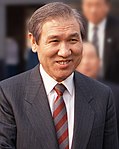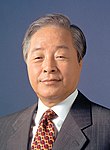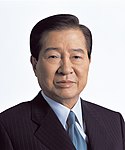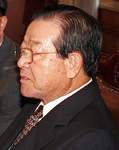| |||||||||||||||||||||||||||||||||||||
| Turnout | 89.15% | ||||||||||||||||||||||||||||||||||||
|---|---|---|---|---|---|---|---|---|---|---|---|---|---|---|---|---|---|---|---|---|---|---|---|---|---|---|---|---|---|---|---|---|---|---|---|---|---|
| |||||||||||||||||||||||||||||||||||||
 Results by provincial-level divisions | |||||||||||||||||||||||||||||||||||||
| |||||||||||||||||||||||||||||||||||||
Presidential elections were held in South Korea on 16 December 1987.[1] They marked the establishment of the Sixth Republic, as well as the end of the authoritarian rule that had prevailed in the country for all but one year since its founding in 1948. They were the first direct presidential elections since 1971, as presidents had been indirectly elected by an electoral college dominated by the governing party in the intervening period.
The elections took place following a series of protests and before the 1988 Summer Olympics, which would be held in Seoul.[2] Roh Tae-woo of the governing Democratic Justice Party won the elections with 37% of the vote. The two major opposition candidates, Kim Young-sam and Kim Dae-jung, received over 55% of the vote between them. Voter turnout was 89%.
- ^ Dieter Nohlen, Florian Grotz & Christof Hartmann (2001) Elections in Asia: A data handbook, Volume II, p420 ISBN 0-19-924959-8
- ^ Hyde, Georgie D.M. (1988-01-01). South Korea : education, culture, and economy. St. Martin's Press. ISBN 0312016662. OCLC 17386117.



